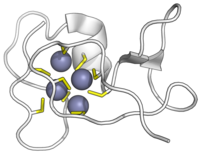Cysteine-rich proteins (CRP, cysteine-rich peptide or disulphide-rich peptide) are small proteins that contain a large number of cysteines. These cysteines either cross-link to form disulphide bonds, or bind metal ions by chelation, stabilising the protein's tertiary structure. CRPs include a highly conserved secretion peptide signal at the N-terminus and a cysteine-rich region at the C-terminus.
Structure
 Example disulphide-linked CRP: a thionein. Cysteines in yellow. (PDB: 1BHP)
Example disulphide-linked CRP: a thionein. Cysteines in yellow. (PDB: 1BHP) Example metal binding CRP: a metallothionein bound to zinc ions. Cysteines in yellow, zinc in purple. (PDB: 1JJD)
Example metal binding CRP: a metallothionein bound to zinc ions. Cysteines in yellow, zinc in purple. (PDB: 1JJD)
Disulphides
In an oxidising environment cysteines cross-link to form disulphide bonds. CRPs that form these typically have an even number of cysteines.
Metal binding
Cysteines can coordinate one or more metal ions by forming a chelation complex around them.
Functions in plants
CRPs are numerous in plants, with 756 CRP-encoding genes in the Arabidopsis thaliana genome. Several CRPs bind known receptors, but most CRP signaling mechanisms and protein interactions are uncharacterized. Characterized CRPs function as short-range intercellular signals during processes such as plant defense, bacterial symbiosis, stomatal patterning, fertilization, vegetative tissue development, and seed development.
Many CRPs function in plant defense. Defensins, a major class of CRP with an eight-cysteine motif forming four disulfide bridges, are involved in pathogen response. Other putative antimicrobial CRPs include lipid transfer proteins, thionins, knottins, heveins, and snakins. Additionally, some CRPs have allergenic, ɑ-amylase inhibitory, or protease inhibitory functions that deter herbivores.
In plant reproduction, CRPs are involved in pollen tube growth and guidance and early embryo patterning, in addition to other functions. Among those involved in pollen tube attraction are the LUREs, a group of ovular pollen-tube attractants in Arabidopsis thaliana and Torenia fournieri that preferentially attract conspecific pollen, and STIG1, a CRP expressed in the stigma of Solanum lycopersicum that interacts with the pollen-specific receptor PRK2. In early embryo development, CRPs such as ESF1 are necessary for suspensor development and normal seed morphology.
References
- Cheek S, Krishna SS, Grishin NV (May 2006). "Structural classification of small, disulfide-rich protein domains". Journal of Molecular Biology. 359 (1): 215–37. doi:10.1016/j.jmb.2006.03.017. PMID 16618491.
- Arolas JL, Aviles FX, Chang JY, Ventura S (May 2006). "Folding of small disulfide-rich proteins: clarifying the puzzle". Trends in Biochemical Sciences. 31 (5): 292–301. doi:10.1016/j.tibs.2006.03.005. PMID 16600598. S2CID 30709875.
- Metallothioneins and related chelators. Sigel, Astrid., Sigel, Helmut., Sigel, Roland K. O. Cambridge: Royal Society of Chemistry. 2009. ISBN 978-1-84755-953-1. OCLC 429670531.
{{cite book}}: CS1 maint: others (link) - ^ Marshall E, Costa LM, Gutierrez-Marcos J (March 2011). "Cysteine-rich peptides (CRPs) mediate diverse aspects of cell-cell communication in plant reproduction and development". Journal of Experimental Botany. 62 (5): 1677–86. doi:10.1093/jxb/err002. PMID 21317212.
- Lavergne, Vincent; J. Taft, Ryan; F. Alewood, Paul (2012-08-01). "Cysteine-Rich Mini-Proteins in Human Biology". Current Topics in Medicinal Chemistry. 12 (14): 1514–1533. doi:10.2174/156802612802652411. ISSN 1568-0266. PMID 22827521.
- Maret, Wolfgang (2008-05-01). "Metallothionein redox biology in the cytoprotective and cytotoxic functions of zinc". Experimental Gerontology. Zinc and Ageing (ZINCAGE Project). 43 (5): 363–369. doi:10.1016/j.exger.2007.11.005. ISSN 0531-5565. PMID 18171607. S2CID 19456564.
- Huang Q, Dresselhaus T, Gu H, Qu LJ (June 2015). "Active role of small peptides in Arabidopsis reproduction: Expression evidence". Journal of Integrative Plant Biology. 57 (6): 518–21. doi:10.1111/jipb.12356. PMID 25828584.
- ^ Huang WJ, Liu HK, McCormick S, Tang WH (June 2014). "Tomato Pistil Factor STIG1 Promotes in Vivo Pollen Tube Growth by Binding to Phosphatidylinositol 3-Phosphate and the Extracellular Domain of the Pollen Receptor Kinase LePRK2". The Plant Cell. 26 (6): 2505–2523. doi:10.1105/tpc.114.123281. PMC 4114948. PMID 24938288.
- ^ Silverstein KA, Moskal WA, Wu HC, Underwood BA, Graham MA, Town CD, VandenBosch KA (July 2007). "Small cysteine-rich peptides resembling antimicrobial peptides have been under-predicted in plants". The Plant Journal. 51 (2): 262–80. doi:10.1111/j.1365-313X.2007.03136.x. PMID 17565583.
- ^ Zhong S, Liu M, Wang Z, Huang Q, Hou S, Xu YC, et al. (May 2019). "Arabidopsis". Science. 364 (6443): eaau9564. doi:10.1126/science.aau9564. PMC 7184628. PMID 31147494.
- ^ Costa LM, Marshall E, Tesfaye M, Silverstein KA, Mori M, Umetsu Y, et al. (April 2014). "Central cell-derived peptides regulate early embryo patterning in flowering plants". Science. 344 (6180): 168–72. Bibcode:2014Sci...344..168C. doi:10.1126/science.1243005. PMID 24723605. S2CID 3234638.
- Kanaoka MM, Higashiyama T (December 2015). "Peptide signaling in pollen tube guidance". Current Opinion in Plant Biology. 28: 127–36. doi:10.1016/j.pbi.2015.10.006. PMID 26580200.